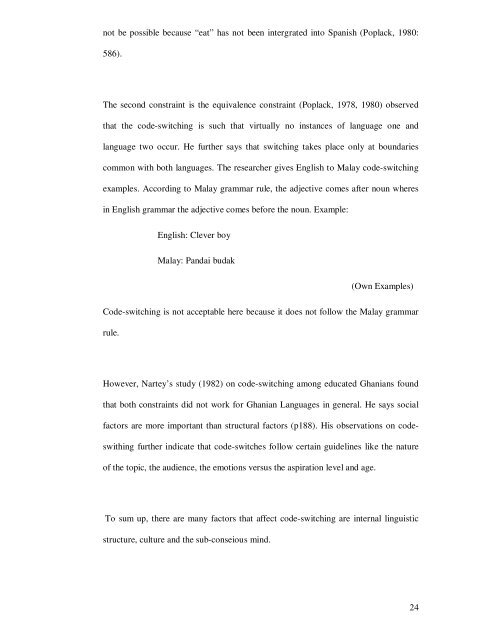CHAPTER 1 1.0 Introduction - DSpace@UM - University of Malaya
CHAPTER 1 1.0 Introduction - DSpace@UM - University of Malaya
CHAPTER 1 1.0 Introduction - DSpace@UM - University of Malaya
You also want an ePaper? Increase the reach of your titles
YUMPU automatically turns print PDFs into web optimized ePapers that Google loves.
not be possible because “eat” has not been intergrated into Spanish (Poplack, 1980:<br />
586).<br />
The second constraint is the equivalence constraint (Poplack, 1978, 1980) observed<br />
that the code-switching is such that virtually no instances <strong>of</strong> language one and<br />
language two occur. He further says that switching takes place only at boundaries<br />
common with both languages. The researcher gives English to Malay code-switching<br />
examples. According to Malay grammar rule, the adjective comes after noun wheres<br />
in English grammar the adjective comes before the noun. Example:<br />
English: Clever boy<br />
Malay: Pandai budak<br />
(Own Examples)<br />
Code-switching is not acceptable here because it does not follow the Malay grammar<br />
rule.<br />
However, Nartey’s study (1982) on code-switching among educated Ghanians found<br />
that both constraints did not work for Ghanian Languages in general. He says social<br />
factors are more important than structural factors (p188). His observations on code-<br />
swithing further indicate that code-switches follow certain guidelines like the nature<br />
<strong>of</strong> the topic, the audience, the emotions versus the aspiration level and age.<br />
To sum up, there are many factors that affect code-switching are internal linguistic<br />
structure, culture and the sub-conseious mind.<br />
24

















